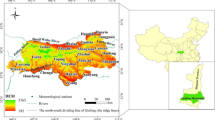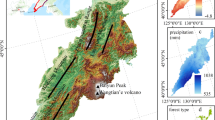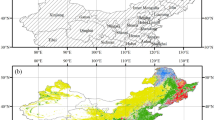Abstract
We detected the spatio-temporal variability in the timing of start (SGS) and end of growing season (EGS) in Japan from 2003 to 2012 by analyzing satellite-observed daily green-red vegetation index with a 500-m spatial resolution. We also examined the characteristics of SGS and EGS timing in deciduous broadleaf and needleleaf forests along vertical and horizontal gradients and then evaluated the relationship between their timing and daily mean air temperature. We found that for the timing of SGS and EGS, changes along the vertical gradient in deciduous broadleaf forest tended to be larger than those in deciduous needleleaf forest. For both forest types, changes along the vertical and horizontal gradients in the timing of EGS tended to be smaller than those of SGS. Finally, in both forest types, the sensitivity of the timing of EGS to air temperature was much less than that of SGS. These results suggest that the spatio-temporal variability in the timing of SGS and EGS detected by satellite data, which may be correlated with leaf traits, photosynthetic capacity, and environment conditions, provide useful ground-truthing information along vertical and horizontal gradients.




Similar content being viewed by others
References
Amano T, Smithers RJ, Sparks TH, Sutherland WJ (2010) A 250-year index of first flowering dates and its response to temperature changes. Proc Royal Soc B 277:2451–2457
Barichivich J, Briffa KR, Myneni RB, Osborn TJ, Melvin TM, Ciais P, Piao S, Tucker C (2013) Large-scale variations in the vegetation growing season and annual cycle of atmospheric CO2 at high northern latitudes from 1950 to 2011. Global Change Biol 19:3167–3183
Chen XQ, Xu L (2012a) Temperature controls on the spatial pattern of tree phenology in China’s temperate zone. Agric For Meteorol 154–155:195–202
Chen XQ, Xu L (2012b) Phenological responses of Ulmus pumila (Siberian Elm) to climate change in the temperate zone of China. Int J Biometeorol 56:695–706
Chen XQ, Luo XZ, Xu L (2013) Comparison of spatial patterns of satellite-derived and ground-based phenology for the deciduous broadleaf forest of China. Remote Sens Lett 4(6):532–541
Chuine I, Kramer K, Hänninen H (2003) Plant Development Models. Phenology: An Integrative Environmental Science, Schwartz MD (Ed.). Kluwer Academic Publishers: Amsterdam, Netherlands, 564 pp
Delbart N, Kergoat L, Le Toan T, Lhermitte J, Picard G (2005) Determination of phenological dates in boreal regions using normalized difference water index. Remote Sens Environ 97:26–38
Doi H (2012) Response of the Morus bombycis growing season to temperature and its latitudinal pattern in Japan. Int J Biometeorol 56:895–902
Doi H, Takahashi M (2008) Latitudinal patterns in the phenological responses of leaf colouring and leaf fall to climate change in Japan. Global Ecol Biogeogr 17(4):556–561
Dorman JL, Sellers PJ (1989) A global climatology of albedo, roughness length and stomatal resistance for atmospheric general circulation models as represented by the simple biosphere model (SiB). J Appl Meteorol 28:833–855
Guyon D, Guillot M, Vitasse Y, Cardot H, Hagolle O, Delzon S, Wigneron J-P (2011) Monitoring elevation variations in leaf phenology of deciduous broadleaf forests from SPOT/VEGETATION time-series. Remote Sens Environ 115:615–627
Hadano M, Nasahara KN, Motohka T, Noda HM, Murakami K, Hosaka M (2013) High-resolution prediction of leaf onset date in Japan in the 21st century under the IPCC A1B scenario. Ecol Evol 3(6):1798–1807
Ibáñez I, Primack RB, Miller-Rushing AJ, Ellwood E, Higuchi H, Lee SD, Kobori H, Silander JA (2010) Forecasting phenology under global warming. Phil Trans Royal Soc B 365:3247–3260
Jönsson P, Eklundh L (2002) Seasonality extraction by function fitting to time-series of satellite sensor data. IEEE Trans Geosci Remote Sens 40(8):1824–1832
Kikuzawa K (1995) The basis for variation in leaf longevity of plants. Vegetatio 121:89–100
Kikuzawa K, Onoda Y, Wright IJ, Reich PB (2013) Mechanisms underlying global temperature-related patterns in leaf longevity. Global Ecol Biogeogr 22(8):982–993
Körner C, Basler D (2010) Phenology under global warming. Science 327:1461–1462
Lim PO, Kim HJ, Nam HG (2007) Leaf senescence. Annu Rev Plant Physiol 58:115–136
Linderholm HW (2006) Growing season changes in the last century. Agric For Meteorol 137:1–14
Luo XZ, Chen XQ, Xu L, Myneni R, Zhu Z (2013) Assessing performance of NDVI and NDVI3g in monitoring leaf unfolding dates of the deciduous broadleaf forest in Northern China. Remote Sens 5:845–861
Matsumoto K (2010) Causal factors for spatial variation in long-term phenological trends in Ginkgo biloba L. in Japan. Int J Climatol 30(9):1280–1288
Matsumoto K, Ohta T, Irasawa M, Nakamura T (2003) Climate change and extension of the Ginkgo biloba L. growing season in Japan. Global Change Biol 9:1634–1642
Menzel A, Sparks TH, Estrella N, Koch E, Aasa A, Ahas R, Alm-Kubler K, Bissolli P, Braslavska O, Briede A, Chmielewski FM, Crepinsek Z, Curnel Y, Dahl A, Defila C, Donnelly A, Filella Y, Jatcza K, Mage F, Mestre A, Nordli O, Penuelas J, Pirinen P, Remisova V, Scheifinger H, Striz M, Susnik A, Van Vliet AJH, Wielgolaski FE, Zach S, Zust A (2006) European phenological response to climate change matches the warming pattern. Global Change Biol 12(10):1969–1976
Motohka T, Nasahara KN, Oguma H, Tsuchida S (2010) Applicability of green–red vegetation index for remote sensing of vegetation phenology. Remote Sens 2:2369–2387
Muraoka H, Ishii R, Nagai S, Suzuki R, Motohka T, Noda H, Hirota M, Nasahara KN, Oguma H, Muramatsu K (2012) Linking remote sensing and in situ ecosystem/biodiversity observations by “satellite ecology”. In: Nakano S, Nakashizuka T, Yahara T (eds) Biodiversity Observation Network in Asia-Pacific Region. Springer Verlag, Tokyo, pp 277–308
Nagai S, Nasahara KN, Muraoka H, Akiyama T, Tsuchida S (2010) Field experiments to test the use of the normalized difference vegetation index for phenology detection. Agric For Meteorol 150:152–160
Nagai S, Saitoh TM, Suzuki R, Nasahara KN, Lee W-K, Son Y, Muraoka H (2011) The necessity and availability of noise-free daily satellite-observed NDVI during rapid phenological changes in terrestrial ecosystems in East Asia. For Sci Tech 7:174–183
Nagai S, Saitoh TM, Kurumado K, Tamagawa I, Kobayashi K, Inoue T, Suzuki R, Gamo M, Muraoka H, Nasahara KN (2013) Detection of bio-meteorological year-to-year variation by using digital canopy surface images of a deciduous broad-leaved forest. SOLA 9:106–110
Natural Environmental Information GIS (1999) National Surveys on the natural environment (5th survey on vegetation). Biodiversity Center of Japan (http://www.biodic.go.jp/index_e.html)
Ogawa-Onishi Y, Berry PM (2013) Ecological impacts of climate change in Japan: the importance of integrating local and international publications. Biol Conservation 157:361–371
Okuda H, Nakashima A, Kushida T, Nakao S, Yamada H, Yabu S (2003) Growth and phenology of Quercus serrata grown under different temperature conditions (in Japanese with English abstract). Environ Engineering Res 40:257–262
Onoda Y, Westoby M, Adler PB, Choong AMF, Clissold FJ, Cornelissen JHC, Diaz S, Dominy NJ, Elgart A, Enrico L, Fine PVA, Howard JJ, Jalili A, Kitajima K, Kurokawa H, McArthur C, Lucas PW, Markesteijn L, Perez-Harguindeguy N, Poorter L, Richards L, Santiago LS, Sosinski EE, Van Bael SA, Warton DI, Wright IJ, Wright SJ, Yamashita N (2011) Global patterns of leaf mechanical properties. Ecol Lett 14(3):301–312
Osada N, Oikawa S, Miyata R, Kamiyama C, Nagano S, Shiodera S, Tabata A, Ono K (2013) Within-species variation in leaf lifespan in relation to environmental factors: general trends and differences across species of different functional types (in Japanese with English abstract). Jpn J Ecol 63:19–36
Peñuelas J, Rutishauser T, Filella I (2009) Phenology feedbacks on climate change. Science 324:887–888
Piao SL, Cui MD, Chen AP, Wang XH, Ciais P, Liu J, Tang YH (2012) Altitude and temperature dependence of change in the spring vegetation green-up date from 1982 to 2006 in the Qinghai-Xizang Plateau. Agric For Meteorol 151(12):1599–1608
Polgar CA, Primack RB (2011) Leaf-out phenology of temperate woody plants: from trees to ecosystems. New Phytol 191:926–941
Reich PB, Walters MB, Ellsworth DS (1997) From tropics to tundra: global convergence in plant functioning. PNAS 94:13730–13734
Rosenthal S, Camm E (1997) Photosynthetic decline and pigment loss during autumn foliar senescence in western larch (Larix occidentalis). Tree Physiol 17:767–775
Schwartz MD, Reed BC, White MA (2002) Assessing satellite-derived start-of-season measures in the conterminous USA. Int J Climatol 22:1793–1805
Schwartz MD, Ahas R, Aasa A (2006) Onset of spring starting earlier across the Northern Hemisphere. Global Change Biol 12:343–351
Schwartz MD, Hanes JM, Liang L (2013) Comparing carbon flux and high-resolution spring phenological measurements in a northern mixed forest. Agric For Meteorol 169:136–147
Secretariat of the Convention on Biological Diversity (2010) Global Biodiversity Outlook 3. Montreal, 94 pp
Shutova E, Wielgolaski FE, Karlsen SR, Makarova O, Berlina N, Filimonova T, Haraldsson E, Aspholm PE, Flø L, Høgda KA (2006) Growing seasons of Nordic mountain birch in northernmost Europe as indicated by long-term field studies and analyses of satellite images. Int J Biometeorol 51:155–166
Stöckli R, Vidale PL (2004) European plant phenology and climate as seen in a 20-year AVHRR land-surface parameter dataset. Int J Remote Sens 25:3303–3330
Studer S, Stöckli R, Appenzeller C, Vidale PL (2007) A comparative study of satellite and ground-based phenology. Int J Biometeorol 51:405–414
Suzuki K (2008) Hydro-atmospheric environment in the Japan Alps area (in Japanese with English abstract). Jpn J Ecol 58:175–182
Suzuki K (2013) Importance of meteorological observation in the Japanese Alps region (in Japanese with English abstract). J Geography 122(4):553–570
Tadaki Y, Kitamura H, Kanie K, Sano H, Shigematsu A, Ohtsu S (1994) Leaf opening and falling of Japanese larch at different altitudes (in Japanese with English abstract). Jpn J Ecol 44:305–314
Tucker CJ (1979) Red and photographic infrared linear combinations for monitoring vegetation. Remote Sens Environ 8:127–150
Ueno K, Isono J, Imaizumi F, Inami A, Kanai R, Suzuki K, Kobayashi H, Tamagawa I, Saitoh TM, Kondo H (2013) Data archive of meteorological data created through the Japanese Alps inter-university cooperative project (in Japanese with English abstract). J Geography 122(4):638–650
van Ommen Kloeke AEE, Douma JC, Ordoñez JC, Reich PB, van Bodegom PM (2012) Global quantification of contrasting leaf life span strategies for deciduous and evergreen species in response to environmental conditions. Global Ecol Biogeogr 21(2):224–235
Viovy N, Arino O, Belward AS (1992) The best index slope extraction (BISE): a method for reducing noise in NDVI time-series. Int J Remote Sens 13:1585–1590
White MA, Thornton PE, Running SW (1997) A continental phenology model for monitoring vegetation responses to interannual climatic variability. Global Biogeochem Cycles 11(2):217–234
White MA, De Beurs KM, Didan K, Inouye DW, Richardson AD, Jensen OP, O’Keefe J, Zhang G, Nemani RR, Van Leeuwen WJD, Brown JF, De Wit A, Schaepman M, Lin X, Dettinger M, Bailey AS, Kimball J, Schwartz MD, Baldocchi DD, Lee JT, Lauenroth WK (2009) Intercomparison, interpretation, and assessment of spring phenology in North America estimated from remote sensing for 1982–2006. Global Change Biol 15:2335–2359
Wright IJ, Reich PB, Westoby M, Ackerly DD, Baruch Z, Bongers F, Cavender- Bares J, Chapin T, Cornelissen JHC, Diemer M, Flexas J, Garnier E, Groom PK, Gulias J, Hikosaka K, Lamont BB, Lee T, Lee W, Lusk C, Midgley JJ, Navas M-L, Niinemets U, Oleksyn J, Osada N, Poorter H, Poot P, Prior L, Pyankov VI, Roumet C, Thomas SC, Tjoelker MG, Veneklaas EJ, Villar R (2004) The worldwide leaf economics spectrum. Nature 428:821–827
Yamamoto M, Nakashima A, Matsumoto N, Yoshida N (2006) Growth and phenology of Acer rufinerve Sieb. et Zucc. grown under warmer conditions (in Japanese with English abstract). J Jpn Soc Revegetation Tech 32(1):112–117
Zhang XY, Goldberg MD (2011) Monitoring fall foliage coloration dynamics using time-series satellite data. Remote Sens Environ 115:382–391
Zhou L, Tucker CJ, Kaufmann RK, Slayback D, Shavanov NV, Myneni RB (2001) Variations in northern vegetation activity inferred from satellite data of vegetation index during 1981–1999. J Geophys Res 106:20069–20083
Zhu W, Tian H, Xu X, Pan Y, Chen G, Lin W (2012) Extension of the growing season due to delayed autumn over mid and high latitudes in North America during 1982–2006. Global Ecol Biogeogr 21:260–271
Acknowledgments
We thank the NASA Land Processes Distributed Active Archive Center in the Earth Observing System Data Gateway for providing the MODIS data. We thank the editor and the two anonymous reviewers for their kind and constructive comments. This work was supported by the Environment Research and Technology Development Fund (S-9; to S. Nagai and R. Suzuki) of the Ministry of the Environment of Japan, by KAKENHI (24710021 and 23710005; Grant-in-Aid for Young Scientists B by JSPS to S. Nagai and T. M. Saitoh), and by the Centre for Environmental Remote Sensing, Chiba University (to S. Nagai and R. Suzuki). We are grateful to Yusuke Onoda (Kyoto University) for his valuable discussions.
Author information
Authors and Affiliations
Corresponding author
Electronic supplementary material
Below is the link to the electronic supplementary material.
Fig. S1
Average daily mean air temperature from 2003 to 2012 in 0–200 m over 35゜−37゜N (bold solid line) and 400–600 m over 43゜−46゜N (dotted line). The range of the multiyear mean timing of the timing of start (SGS) and end of growing season (EGS) in deciduous broadleaf forest (DBF) and deciduous needleleaf forest (DNF) was shown in the top of figure (gray shaded). (JPEG 165 kb)
Fig. S2
Distribution of the average effective cumulative temperatures (ECT) for the timing of start (SGS) and end of growing season (EGS) in deciduous broadleaf forest (DBF) and deciduous needleleaf forest (DNF). Gradients are vertical (y-axis) and horizontal (x-axis). (a) SGS in DBF; (b) SGS in DNF; (c) EGS in DBF; (d) EGS in DNF. N/A: not available. (JPEG 322 kb)
Table S1
Summary of the linear regression function of the timing of start (SGS) and end of growing season (EGS) along the vertical gradient in deciduous broadleaf forest (DBF) and deciduous needleleaf forest (DNF) in different latitude zones (DOCX 25 kb)
Rights and permissions
About this article
Cite this article
Nagai, S., Saitoh, T.M., Nasahara, K.N. et al. Spatio-temporal distribution of the timing of start and end of growing season along vertical and horizontal gradients in Japan. Int J Biometeorol 59, 47–54 (2015). https://doi.org/10.1007/s00484-014-0822-8
Received:
Revised:
Accepted:
Published:
Issue Date:
DOI: https://doi.org/10.1007/s00484-014-0822-8




